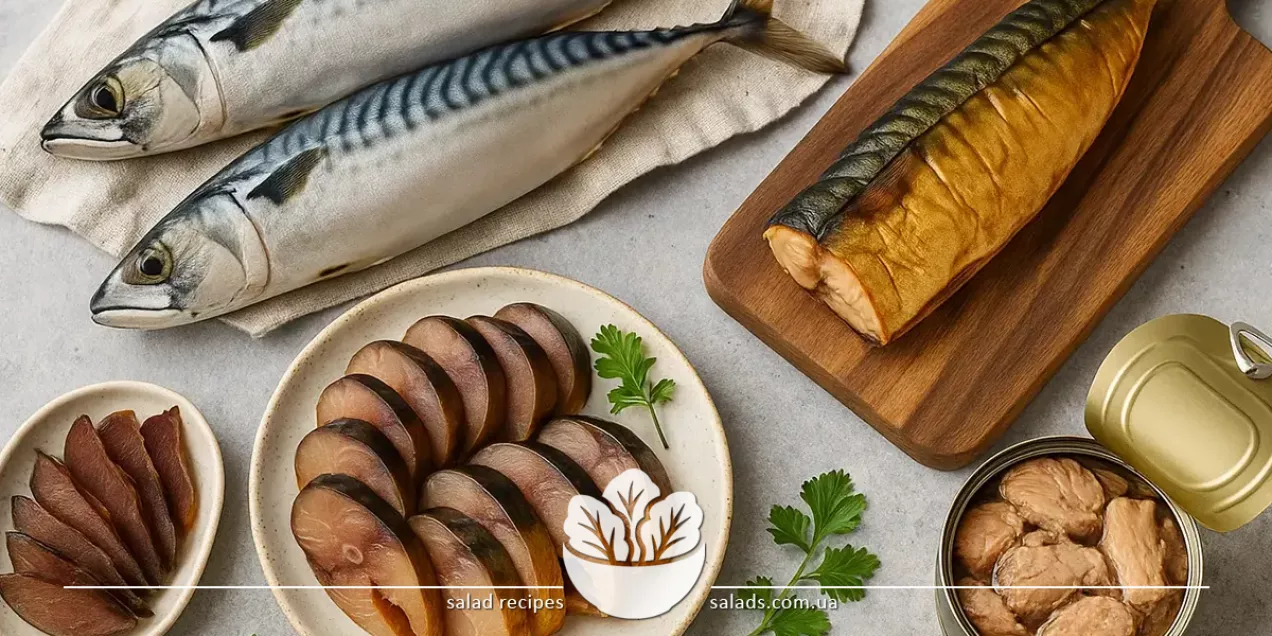Types of Mackerel

Types of mackerel include a variety of this popular marine fish, which is an important source of protein, fats, and omega-3 fatty acids. In culinary applications, mackerel holds an honored place due to its juicy flesh, rich taste, and versatility in preparation. Depending on the fishing region and specific species, the fish may vary in color, texture, size, and fat content. Within the fish category, mackerel is often used as a base for appetizers, main courses, smoked products, and canned foods.
Different Types of Mackerel
Atlantic Mackerel: A Versatile Choice for Any Kitchen
Atlantic mackerel is the most well-known and widely consumed variety of this fish in Europe and North America. It inhabits the northern Atlantic Ocean as well as the Baltic, North, and Mediterranean Seas. This mackerel has a streamlined, spindle-shaped body with distinct dark stripes on the back, shiny sides, and a white belly. It typically measures 25-40 cm in length and can weigh up to 1 kg. Thanks to its high fat content (up to 13%), Atlantic mackerel is ideal for hot and cold smoking, grilling, baking in foil, stewing with vegetables, and marinating. Its flesh remains tender and juicy even after prolonged heat treatment, making it a very adaptable ingredient. It can be stuffed, baked whole, or cut into steaks, allowing for experimentation with spices and sauces.
As part of a healthy diet, Atlantic mackerel is an excellent source of omega-3 fatty acids, vitamins D and B12, and highly digestible protein. With its rich taste, it pairs well with neutral side dishes – from roasted vegetables to grains and legumes. For example, boiled mackerel complements avocado in salads, where the combination of healthy fats and fiber ensures both satiety and nutritional value. Atlantic mackerel is available fresh, chilled, frozen, and canned, making it convenient for home cooking and foodservice. It retains its flavor and texture even after freezing or canning, remaining one of the most popular fish in today’s diet.
Japanese Mackerel: Distinct Texture and Culinary Specificity
Japanese mackerel (Scomber japonicus), also known as Pacific or chub mackerel, is characterized by a denser texture and lower fat content compared to the Atlantic variety. This species is found in the Pacific Ocean near Japan, China, Southeast Asia, and Oceania. It has a slightly narrower body, a greenish-blue back, and less prominent stripes. It is lighter than the Atlantic mackerel but retains its distinctive aroma and flavor. Culinary preparation of Japanese mackerel requires a different approach. Due to its lower fat content, it is better suited for quick frying, baking, stir-frying, or as a sushi filling. In traditional Japanese cuisine, it is often served grilled over charcoal or as fillets marinated in rice vinegar. It pairs well with rice, vegetables, and sweet-spicy sauces.
This mackerel variety is lower in calories and easier to digest, making it popular among people following diets or monitoring fat intake. It is commonly used in quick meals – such as rice rolls or fish patties. Combined with ingredients that have a delicate texture, Japanese mackerel creates an appealing flavor composition. Its mild flavor is well complemented by other seafood, legumes, or spicy accents. For example, braised Japanese mackerel can be served with chickpea puree or a salad that includes soft cheese, creating harmony between richness and delicacy.
Australian Mackerel: Large, Fatty and Flavourful
Australian mackerel, or Spanish mackerel (Scomberomorus commerson), stands out among other types for its large size, high fat content and strong flavour. It is a predatory species found in the warm waters off the coast of Australia, Southeast Asia and India. Adults can exceed a metre in length and weigh over 10 kg, making them attractive for both commercial fishing and high-end gastronomy. Thanks to its high fat content, the flesh of Australian mackerel has a rich taste and holds up well to various types of cooking. It can be grilled, pan-fried in thick steaks, braised with spices or cooked over open flame. This species is commonly used in South Asian dishes, where mackerel pairs well with spicy sauces, coconut milk, citrus and aromatic herbs.
Australian mackerel is especially delicious when cut into thick cross-section steaks with the backbone intact – they stay juicy even when grilled or seared at high heat. Combined with bold sides such as vegetables in soy sauce or spicy rice, the meaty mackerel reaches its full potential. For example, it is often served with chicken eggs in Asian-style bowls or salads. Besides its intense flavour, Australian mackerel is a great source of fat-soluble vitamins A and D, as well as omega-3 fatty acids that benefit the skin, cardiovascular system and brain function. It is ideal for athletes and anyone requiring a protein-rich diet. In fine dining, Australian mackerel is frequently served as a main course – often paired with creamy sauces, aromatic side dishes or sweet-and-sour marinades.
African Mackerel: An Accessible Base for Everyday Meals
African mackerel is a general term for several regional mackerel populations caught off the west coast of Africa. Its main advantages are affordability, good taste, relatively high fat content and wide availability in different forms: frozen, smoked, salted or canned. This is the most common type of mackerel found in the budget section of grocery stores and is a staple in home cooking. Visually, African mackerel is nearly identical to Atlantic mackerel, though its flesh may be slightly less firm and its fat content more variable depending on the catch location. Its accessibility makes it a popular choice for baking in foil, stewing with vegetables, adding to soups or using as a base for spreads and salads. Its consistent taste makes it suitable for everyday meals.
This type of mackerel pairs well with many common ingredients – potatoes, carrots, grains, eggs or pickles. For instance, in a simple salad with cooked mackerel, pairing it with boiled rice balances the saltiness of the fish and adds substance. It’s also often used to make fish cakes, pie fillings or spreads for bread. African mackerel is easy to prepare and cooks quickly, making it convenient for everyday meals. When combined with different vegetables and sauces, it adapts well to a variety of flavour preferences and works well in both hot and cold dishes. Despite its simplicity, it remains a dietary staple for many due to its balance of cost, nutrition and versatility.
Mackerel in the Diet: Nutritional Value and Culinary Versatility
Mackerel, regardless of species, is a valuable source of protein, healthy fats and micronutrients. Rich in omega-3 fatty acids, vitamins D and B12, and minerals such as selenium, phosphorus and iodine, it plays a vital role in a healthy diet. Regular consumption of mackerel helps regulate cholesterol levels, supports cardiovascular function, and improves skin condition and cognitive performance. In this way, mackerel is more than just a fish – it’s a truly functional food. In cooking, mackerel is highly versatile. It can be used in soups, salads, appetisers, grilled dishes, stews and preserves. It is equally at home in everyday meals and gourmet recipes. This flexibility allows mackerel to pair well with a wide range of side dishes – from vegetables and grains to legumes and even fruit.
Mackerel pairs especially well with sour or slightly bitter ingredients that offset its richness. For example, salads featuring cabbage, mustard, horseradish or citrus highlight its distinct flavour. It’s also popular with aromatic herbs, spices, soy-based sauces or creamy dressings. One classic recipe is baked mackerel with apples and onions, where the fish’s saltiness is balanced by the sweet-sour notes of the garnish. Beyond its taste, mackerel remains an economically accessible fish, making it an ideal option for a balanced diet. It’s perfect for a quick weeknight dinner or a festive meal. For these reasons, mackerel – in all its varieties – has earned a lasting place in the culinary traditions of many cultures and continues to enjoy widespread popularity.
